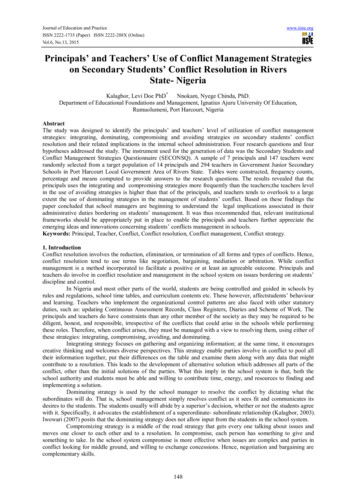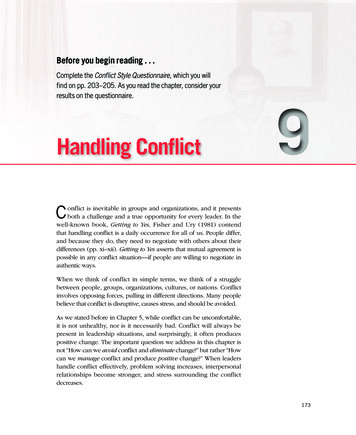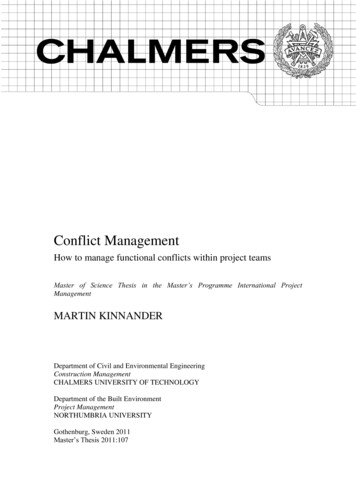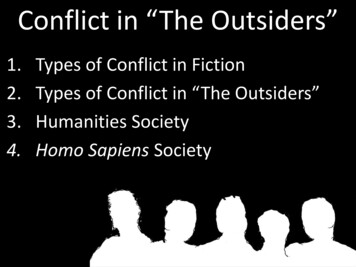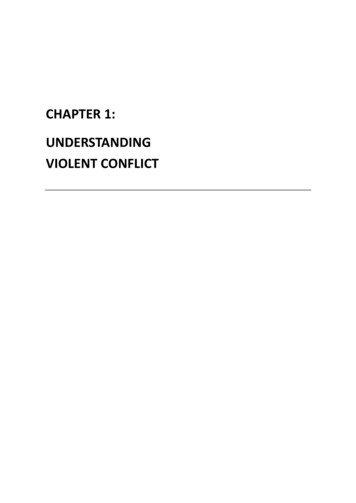
Transcription
Psychological Reports, 1978,42, 1139-1145. @ Psychological Reports 1978COMPARISON OF FOUR INSTRUMENTS MEASURINGCONFLICT BEHAVIOR1K E N N I T H W. THOMASTemple UniversdyANDWH H. KILMANNUniversity of PittsburghSummary.-Test-retest reliabilities, internal consistencies, and convergenttest validities were examined for four measures of interpersonal behavior inhandling conflict. Subjects were 86 graduate students in management. Instruments were those developed by Blake and Mouton, Lawrence and Lorxh, Hall,and by Thomas and Kilmann. Reliabilities were in the low-to-moderate range,with more recent instruments somewhat superior. Some problems with the firsttwo measures were observed. The two most recent instruments, by Hall andby Thomas and Kilmann, show some convergence across all five modes ofhandling conflict. Convergence among other instruments varies by mode ofhandling conflict. .Inspection of items suggests some reasons for the limitedconvergence.Since the mid-1960s, variations of a five-category scheme for classifyinginterpersonal conflict-handling behavior. have gained prominence in organizational reseatch. Thomas (1976) interprets this newer classification system ascombining ,pvo independent dimensions: cooperation, or attempting to satisfythe other party's concerns, and assertiveness, or attempting to satisfy one's ownconcerns. Five conflict-handling modes are plotted along these two dimensions:competition is assertive and uncooperative, collaboration is assertive and cooperative, avoiding is unassertive and uncooperative, acconzmodatio?z is unassertiveand cooperative, and comp omiseis intermediate in both assertiveness and cooperativeness. Semantic differential studies (Ruble & Thomas, 1976) haveindicated this scheme's close correspondence to subjective dimensions used byindividuals in situations of conflict. Terminology for the two underlying dimensions and the five modes of handling of conflict has varied somewhat amongresearchers (e.g., Blake & Mouton, 1964; Hall, 1969; Thomas, 1976).Studies investigating the -five modes of handling conflict in organizationshave almost exclusively used self-report instruments. However, there has beenno systematic attempt to measure important psychometric properties of theseinstruments. Accordingly, this study assessed test-retest reliabilities, internalconsistencies, and the intercorrelations or convergent test validities of four instruments currently available for measuring behavior in handling conflict. Theinstruments were those designed by Blake and Mouton (1964), Lawrence andLorsch ( 1967), Hall ( 1969), and Thomas and Kilmann (1974).'Portions of this research were supported by the Insticute of Industrial Relations, UCLA.The authors are also indebted to Anne Lamb, Gib Akin, and David lamieson for theirhelp with the study.
1140K. W.THOMAS&R. H.KILMANNMETHODSab jectsSubjects were 86 students in three sections of a graduate course in Behavioral Science for Management at the University of Pittsburgh. Each subjectcompleted a package of instruments containing the four instruments arrangedin random order, followed by three measures of response style not relevant tothis study. Four weeks later these subjeccs again completed the instrumentsmeasuring mode of handling conflict; these were re-randomized for individualsubjects.The Conflict InstrzlmentsIn order to make the results of the four instruments comparable, somechanges were made in the instructions of rwo of the instruments. Althoughthese changes did not in any way alter the items of the instruments and seemednecessary to more directly compare the four instruments, it is conceivable thatthese changes have in some way affected the results. Perhaps this possibilitycould be investigated in the future.The Blake-Mouton instrument on conflict consists of five statements, eachdescribing one mode of handling conflict. As used in Managerial Grid labs,subjects had been asked to select the single statement which best describedthem. For this study, subjects were asked to rank the five statements frommost to least typical, as descriptions of their own behavior.The Lawrence-Lorsch instrument consists of 25 proverbs describing thefive modes of handling conflict. Subjects rate these proverbs on how well theydescribe the behavior of the people within their organization. This study usedBurke's (1970) modification of the Lawrence-Lorsch response categories andasked subjects to rate each proverb on the extent to which it described their ownapproach to disagreements. The response categories ranged from "(1) not atall-this behavior never occurs" to " ( 5 ) to a very great extent-this behaviorusually occurs."The Hall instrument has 12 groups of statements. Preceding each groupof five statements, there is a general introductory sentence about conflict phenomena followed by a question about the subject himself. The subject is required to rate each of the five statements from 1, "completely uncharacteristic,"to 10, "completely characteristic." Moreover, subjeccs are not allowed to assignthe same ratings to any two of the statements, so that subjects in effect both rateand rank the statements. The instructions required no changes for the presentstudy.The Thomas-Kilrnann instrument has 30 pairs of statements describingmodes of handling conflict. Each mode is paired with the other four modes anequal number of times. Subjects are asked to choose the statement in each pairthat best describes their behavior in a conflictful situation: A profile of behavior
1141MEASURING CONFLICT BEHAVIORfor handling conflict is obtained by summing for each mode the number of statements the subject endorses. This instrument is specifically designed to minimizethe effect of social-desirability response bias (Kilmann & Thomas, 1977).RESULTSTest-retest ReliabilityThe test-retest reliabilities of mode scores on the four instruments areshown in Table 1. Mean reliabilities are also shown to facilitate over-all comparisons between instruments. Instruments are arranged from left to right inthe table according to increasing reliability for this sample. Reliabilities rangefrom low to moderate on individual scales. The Blake-Mouton items for competition and compromise are especially unstable in this sample. Table 1 mightalso show the tendency for instruments with more items to have higher reliabilities than shorter or single-item measures.TABLE 1.TEST-RETESTRELIABILITIESOF SCORBSON FOUR INSTRUMENTS FOR MODEOFHANDLINGCONFLICT( N 76)Modes of HandlingInstrumentsConflictBlake- outo on .66.68.62.64Internal ConsistencyThe internal consistencies of items measuring each of the five modes ofhandling conflict were calculated for the Lawrence-Lorsch, Hall, and Thomas.Kilmam instruments using coefficient alpha (Cronbach, 1951 ). These appearTABLE 2INTERNALCONSISTENCIES(COEFFICIENTa) ON ITEMS FOR MODEOF HANDLINGCONFLICTON LAWRENCE-LORSCH,HALL,AND THOMAS-KILMANNINSTRUMENTS( N 86)Modes of HandlingConflictLaw rence-Lorsch( 1767 65.
K. W. THOMAS & R. H. KILMANN1142in Table 2. Coefficients are in the low-to-moderate range. The ordering ofthese instruments by mean internal consistency of scales is the same as for testretest reliability.Comergent Test ValidityTable 3 contains intercorrelations among the four instruments on each ofthe five modes of handling conflict. The competition, collaborating, and avoiding scores of the four instruments are moderately correlated, while the intercorrelation of accommodation scores is low, and compromising almost negligible.TABLE 3INTERCORRELATIONOF SCORESFOR MODEOF HANDLINGCONFLICTAMONGFOURINSTRUMENTS(N 86).,Modes of ionLawrence-Lorsch Hall.59t.36 .35 .41 .37 .37 .23*.47 .21*.22*.02.02.24*.40 .32t.39 .34 .49 -.07.13.ll-15.37 .09.02.20 Thomas-Kilmann.16.05,one-tail. tp .01, one-tail. pHall*pInstrumentsLawrence-LorschBlake-Mouton .26t.17 .001, one-tail.27tDISCUSSIONOver-all reliability coefficients for the four instruments fall within the lowto-moderate range, with most scales showing moderate reliabilities. In thepresent sample both test-retest reliability and internal consistencies show a tendency to improve with the chronological order of instrument development, withmore recent instruments somewhat superior to earlier ones.With respect to convergent validity, the two most recent instruments, theHall and Thomas-Kilmann instruments, are correlated across all five modes ( P4 .O5). Convergence between remaining pairs of instruments varies markedly by mode of handling conflict.There is moderate convergence among all four instruments on collaboration,
MEASURING CONFLICT BEHAVIOR1143competition, and (to a somewhat lesser degree) avoiding. All pairwise correlations between instruments are significant on these modes, except for two correlations involving the Blake-Mouton item on avoiding. Those three modesresemble Horney's (1945) familiar dassification of interpersonal behavior intomovement "toward," "against," and "away from" the other person, respectively.Convergence among the instruments on these three modes may stem in partfrom the instrument designers' greater familiarity with these behavioral concepts, which are somewhat more established in the behavioral literature.In essence, the five-category scheme identifies two forms of cooperation(or "movement toward the other") in addition to collaboration. The presentresults indicate divergences among instruments in operationalizing these modesof handling conflict. The unassertive form of cooperation is called "accommodation" by Thomas (1976), "smoothing" by Blake and Mouton (1964) andLawrence and Lorsch (1967), and "yield-lose" by Hall (undated). Inspectionof items for this mode indicates that the Hall instrument stresses the avoidanceof conflict-related threats to a relationship, the Thomas-Kilmann items stresspaying sole attention to satisfying the other person's concerns, the LawrenceLorsch items emphasize gentleness, and the Blake-Mouton item mentions bothattempting to avoid conflicts and attempting to maintain harmony when conflictoccurs. Some of these differences,appear to reflect underlying design objectives.Both the Blake-Mouton .and Hall instruments are designed to identify a basicmotivation or style ("1, 9") which may be manifested in two major kinds ofintentions-avoiding disruptive conflicts and maintaining harmony once conflict has arisen. The Lawrence-Lorsch instrument appears to equate this same"smoothing" orientation with simple gentleness of manner, although the underlying motivation or intent for this manner is not spelled out as it is within theHall and Blake-Mouton items. In contrast, the Thomas-Kilmann instrument isdesigned to identify a more specific behavioral intention (accommodation) andto distinguish it from avoiding and other intentions.The final mode, compromise, is intermediate in both assertiveness andcooperativeness, occupying the mid-point of the two-dimensional classificationscheme. The present results show negligible convergence among the four instruments on thismode, with the exception of the small correlation between theThomas-Kilmam and Hall measures. Again, both the Blake-Mouton and Halljnstruments seem intended to identify an underlying style ( " 5 , 5 " ) which ishypothesized to be expressed in a mix of behavioral intentions. The Hall itemsmention a kind of moderated competition-pushing one's concerns but stoppingfor a compromise if there is a danger of damaging the relationship. Seven ofthe 12 Hall items mention the theme of pushing one's concerns short of thepoint of offending, while the remaining five items specifitally mention compromise. The Blake-Mouton item appears double-barreled and abstract (. . . "I
K. W. THOMAS1144&R. H. KILMANNtry to be fair but firm and to get an equitable solution"), which may explainits very low test-retest reliability ( I . .14). Again, the Thomas-Kilmann isdesigned in a contrasting manner to assess a specific behavioral intention, compromise, as distinct from competition and the other modes. Eight of the 12Thomas-Kilmann items refer to seeking a compromise or middle-ground position, while the remaining four items refer operationally to the exchange ofconcessions. Finally, the Lawrence-Lorsch items focus primarily on the themeof exchange, e.g., "Tit for tat is fair play," but in all but one case do not specifyeither an exchange of concessions or the resulting combination of gains andlosses which might more dearly identify this exchange as compromise.With respect to an over-aLI comparison of instrurnents, this study and discussion indicate some problems with two of the instruments. The Blake-Moutoninstrument had low test-retest reliabilities on two modes. The Lawrence-Lorschinstrument also has somewhat lower reliabilities than the Thomas-Kilmann andHalI instruments for this sample. Moreover, an inspection of items on accommodation (or smoothing) and compromise suggests that these two modes maynot be sufficiently well identified or distinct from other modes of conflict.This impression is consistent with previous factor analyses of the LawrenceLorsch items (Lawrence & Lorsch, 1967; Ryan & Clemence, 1973), which haveshown only three factors-collaboration, competition, and a third one whichvaries from accommodation (smoothing) items to a mixture of accommodationand avoiding items. The two remaining instruments, the Thomas-Kilmann andHall instruments, show somewhat higher reliabilities and some degree of convergent test validity across all five modes o
Summary.-Test-retest reliabilities, internal consistencies, and convergent test validities were examined for four measures of interpersonal behavior in handling conflict. Subjects were 86 graduate students in management. Instru- ments were those developed by Blake and Mouton, Lawrence and Lorxh, Hall, and by Thomas and Kilmann. Reliabilities .




